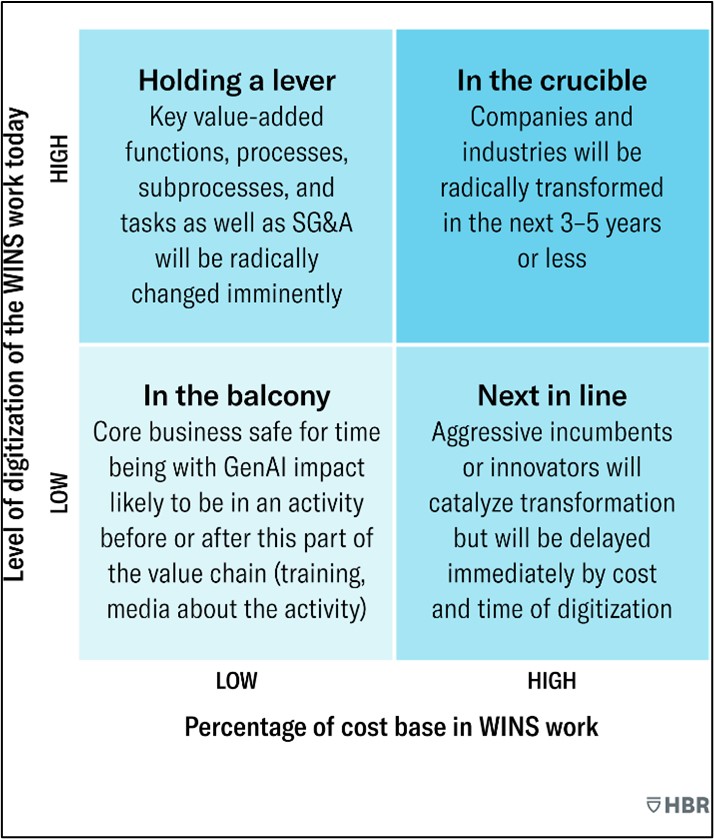GenAI is the latest business fad. You can’t escape it. Consulting firms are churning out dozens of articles about genAI every week. Not surprisingly, many of them are similar to each other but not very good. It is possible to grab people’s attention and add value to the topic, but not by producing another of these me-too articles.
Interest in genAI has skyrocketed since OpenAI released ChatGPT in late 2022 (Google Trends)

As I wrote in this 2023 post, many articles assert that genAI can do things that it can’t, such as streamline a supply chain, discover new drugs, and eliminate a quarter of all jobs. One leading consulting firm argues that since genAI is based on data, manipulating it is a core strength. It isn’t. Large language models aren’t good at math.
So, why are we drowning in poor-quality content about genAI? There are two main reasons.
Experts often suffer from the Dunning-Kruger effect. Being an expert in one area, they presume they are expert in others. That gives them confidence to write about the next new thing, even if they have little experience with it. And when it comes to genAI, few do.
Readers have a bias for novelty. They want to hear about the new, new thing not the old boring stuff. And because people (especially busy ones) prefer to consume content quickly, they’ll often read hastily drafted commentary rather than in-depth analysis that might have taken days or weeks to write.
This combination of inexpert writers and undiscerning readers has created a flood of poor-quality content about genAI.
Thought leadership, or business writing about something new, does not have to be dramatic or hyperbolic. Here are two useful articles about genAI in business.
This one, How Corporate And Investment Banks Are Tackling GenAI, starts out by discussing how leading corporate and investment banks (CIBs) have already used AI, machine learning, and large language models. Then it explains what genAI can do – interpreting existing and generating new content – that could help some banking functions. It gives examples of how it might be deployed, such as sorting through regulators’ reports, finding the most relevant, and writing a synopsis for someone to act on. By the time it describes the ingredients for success and the risks to watch out for, the reader can be confident that the authors know what they are writing about.

Here’s another: Where Should Your Company Start with GenAI? The authors start by acknowledging that oft-touted macro-impacts like job losses and societal risks are important, but not helpful to executives and board members today. So they recommend looking at immediate opportunities and threats through a filter they call WINS, which words, images, numbers, and sounds genAI can manipulate and interpret to add value. Then, they present a rare animal, a useful 2×2 matrix that helps any company decide how urgent it is for them to act. Their prescriptions are fairly generic, but that doesn’t matter. The real value is in separating what’s important from what isn’t and giving executives a way to figure out how critical it is for them.
I found these articles by searching for “Best genAI articles” and vetting the first 30. There were nine poor ones for each good one I found, as Sturgeon’s Law (which says 90 percent of everything is crap) would predict.
The key to writing a value-adding article about genAI is to keep it grounded in reality. Avoid claiming even greater benefits and transformation than the last guy. Recap what genAI is actually good at, interpreting and generating content. Explain how that might add value to the sector or function you’re talking about. Find actual examples and extrapolate some realistic hypotheticals. Then, if you like, talk about the next steps, necessary resources, and risks. Those will usually be somewhat generic, so don’t spend too much time on them; a good manager can deduce from what they must do how to do it.
I’m a bit cynical by nature, so I (genuinely) appreciate others getting enthusiastic about the latest innovation. However, their declarations are more useful if they are realistic.



